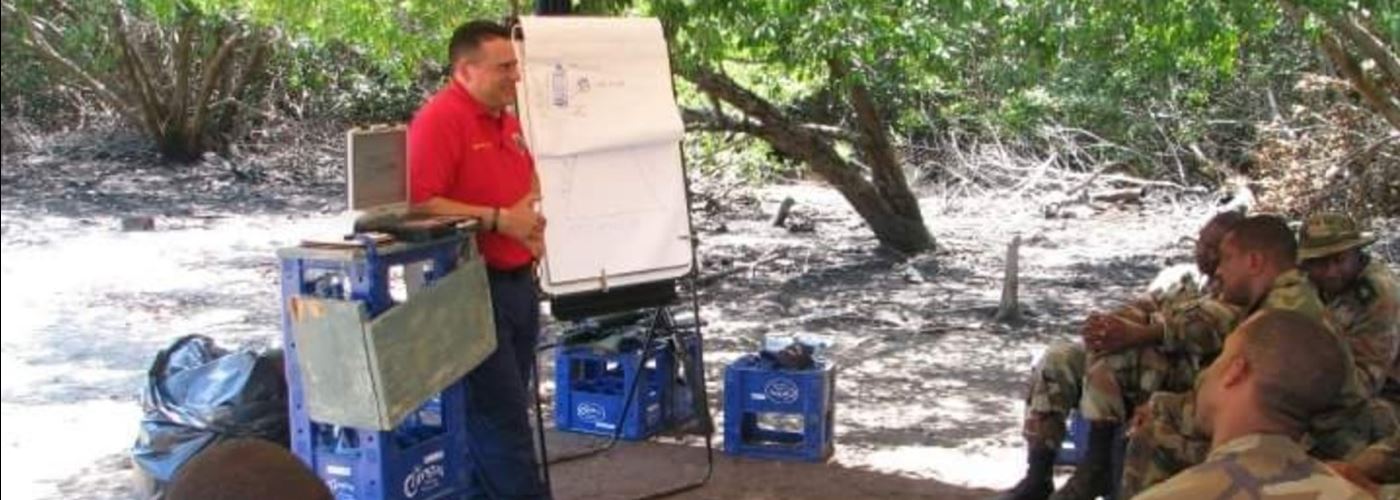
3 anecdotes from my 25 years of teaching
Those of us with military experience may remember the command, "Classroom Circle!" Normally something you heard outside, a "classroom circle" huddle was perfect for a quick new lesson or safety briefing from a non-commissioned officer to his experienced shooters before stepping onto the firing line.
Sometimes the teaching space would be a little more formal, seated on bleachers or even in a classroom. Maybe it was for learning a new weapon system, some major policy changes or anything that the commanders needed "done right."
As instructors, we want the best setting in which we can teach and the right tools so that our shooters can learn. But it doesn't always work out that way. Here are three anecdotes from my time as a firearms instructor.
1. Roughing It
I once had to teach for a week, lecturing on use of force, deadly force and defensive tactics to a group of international military students in Central America. I was part of an instructor team—which included Eddy Boyd and Stephen Kelly—deployed in support of a larger training operation.
On the first day, at the last minute, we got bumped out of our classroom by the organizers. We found ourselves on the only other space available to us for a few days: a muddy riverbank, at the edge of the jungle, out in 124° heat at 8 a.m. (Good thing we arrived early.) It was at the riverbank, because we were expected to run a training scenario aboard a small ship by the end of the week. At the risk of causing an international incident, we pushed back on the organizers, insisting that the learning experience had to be done right.
"Students dropping out from the heat can't exactly pay attention," we protested. "And it rains every afternoon here! We need a classroom."
That got us a decently sized little canopy tent at the muddy riverbank, but no projector for our slideshows. When we asked about chairs, we received a very generous pallet of empty milk crates. We couldn’t keep the wooden pallet, but we sure got all the mosquitoes we could stand! There were no vacant classrooms until the third day. It was rough, but we had to make it work in that teaching space.
It certainly helped that I was teamed up with two solid instructors. We had all brought our own sets of professional markers, big paper flipcharts, reference manuals and everything else we thought we'd need.
We set up the "chairs" in u-shaped rows around the training mats. We divvied up the topics and recreated the more important slides on the flipcharts. We gave the students plenty of breaks and came up with games to review the lessons at the end of each day.
By the end of the week, our students successfully completed the scenario aboard the ship. They said they enjoyed our classes. They never knew how aggravated we were. Stuck with a rough teaching space, we got creative, and we made it work.
2. Technical Difficulties
Back in the U.S., and for a different set of classes, I had a day off when an instructor/teammate called me in bit of a panic. Wes Mundy was a good instructor, but that morning, our overhead projector and laptop were just not "speaking" to each other.
The image was projecting way out of frame, and not simply in a way that re-aiming the beam would fix. It was some weird, advanced setting. He had been through all the troubleshooting he could think of before calling me, and the class was arriving. They were about 60 military students, from new specialists up through all the ranks to a very senior commander. I talked my buddy through all the troubleshooting I could recall without the system in front of me, but we had no luck.
At that point, it was about 8:24 a.m. and the class was all seated, staring at him talking with me on his cellphone. With no other choice, I told him to call up the youngest person in the room and quietly tell them to fix it. The gamble worked! That kid was about 18 years old, and he knew exactly how to fix it. The quick laugh broke the ice, and they had a good training class. The student had helped save the tech for that teaching space!
3. Too Cool for School
If you've been shooting for a while, you might have shooting ranges you prefer over others. Sometimes it matters more to match your classes to the ranges at your disposal.
My lieutenant once told us, "Shooting in 36° weather, when the students' fingers and guns are shivering, certainly isn't good training."
We had complained about early classes on an outdoor range. He rescheduled our classes to times and ranges best suited for teaching and learning. He was good like that, one of the best bosses I ever worked for. That lieutenant was Tony Crisco, and we are friends to this day.
Many of you are self-employed instructors. You can be your own "best boss."
What does this mean for you?
You might be asking yourself, “Why does all this matter? Can't my students and I tough it out without fancy equipment and just get started shooting?”
Well, yeah. But what if they're all new shooters? You’ll want to take your time on a few things. If you've studied adult learning theory, you know people respond differently to various types of instruction. In our own, early years of schooling, we were little children, seated in rows, facing the teacher and the blackboard. It was a rigid and structured experience. But when a TV was up in front, that made us happy! We know now that there's an art and a science to sharing knowledge with adults.
The more ways you can deliver the message you’re teaching, the more students you’ll reach. This is especially true when it comes to new shooters and safety lessons or the intricacies of disassembly and cleaning their firearms. Plus, some students may have paid good money for your classes. You'd like them to enjoy the training and become “repeat cu$tomer$,” right?
Invest in a course for yourself that teaches you about adult learning. Then decide what kind of teaching space you want for optimal learning in each of your shooting classes.
Let’s Recap
Put some thought into preparing your Teaching Space:
- Bring what YOU need to get the job done. Make arrangements for other supplies ahead of time, such as markers, dry erase boards, inert/training weapons, medical supplies, targets, backers, any behind-the-scenes support, etc.
- High tech tools might make our job easy.Use them! But, have a plan in case they let you down, whether that’s having spare batteries on hand or just omitting the tech all together.
- Is the teaching space conducive to learning? Will it work for all types of learning? Are there any distractions? Is it safe?
Can considering all the above mean more effort? Yes. It often takes two hours of prep for every one hour of standing in front of students (at least the first time you present a particular class). But if you think back to why you started teaching in the first place, you'll remember that you wanted to "do it right." Keep that sentiment with you. And have a good class!
Want more tips for improving your shooting classes? Stay tuned to the ShootingClasses.com blog. While you’re here, find out how you can streamline administrative management for your firearms training business.
